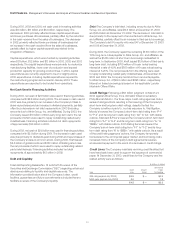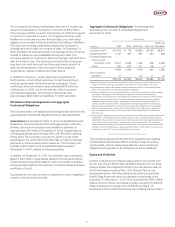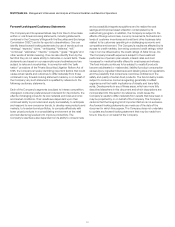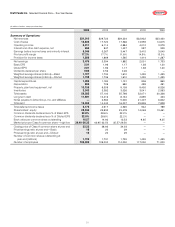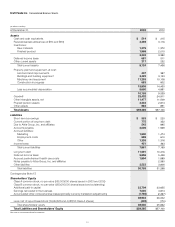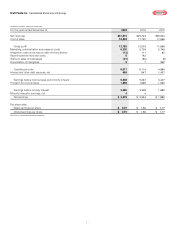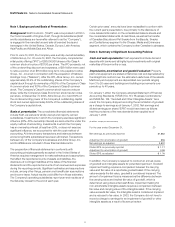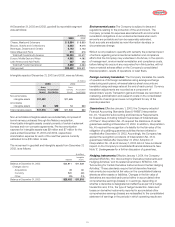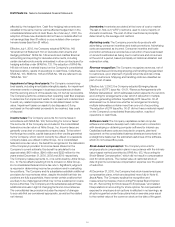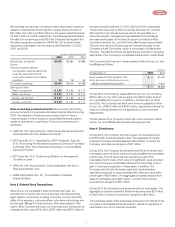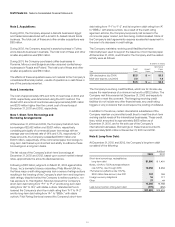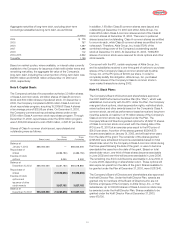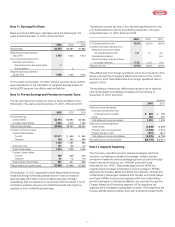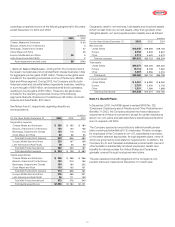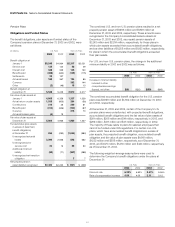Kraft 2003 Annual Report Download - page 46
Download and view the complete annual report
Please find page 46 of the 2003 Kraft annual report below. You can navigate through the pages in the report by either clicking on the pages listed below, or by using the keyword search tool below to find specific information within the annual report.
44
Kraft Foods Inc. Notes to Consolidated Financial Statements
Note 1. Background and Basis of Presentation:
Background: Kraft Foods Inc. (“Kraft”) was incorporated in 2000 in
the Commonwealth of Virginia. Kraft, through its subsidiaries (Kraft
and its subsidiaries are hereinafter referred to as the “Company”),
is engaged in the manufacture and sale of branded foods and
beverages in the United States, Canada, Europe, Latin America,
Asia Pacific and Middle East and Africa.
Prior to June 13, 2001, the Company was a wholly-owned subsidiary
of Altria Group, Inc. On June 13, 2001, the Company completed an
initial public offering (“IPO”) of 280,000,000 shares of its Class A
common stock at a price of $31.00 per share. The IPO proceeds, net
of the underwriting discount and expenses, of $8.4 billion were used
to retire a portion of an $11.0 billion long-term note payable to Altria
Group, Inc., incurred in connection with the acquisition of Nabisco
Holdings Corp. (“Nabisco”). After the IPO, Altria Group, Inc. owned
approximately 83.9% of the outstanding shares of the Company’s
capital stock through its ownership of 49.5% of the Company’s Class
A common stock and 100% of the Company’s Class B common
stock. The Company’s Class A common stock has one vote per
share, while the Company’s Class B common stock has ten votes
per share. At December 31, 2003, Altria Group, Inc. held 97.9% of
the combined voting power of the Company’s outstanding capital
stock and owned approximately 84.6% of the outstanding shares of
the Company’s capital stock.
Basis of presentation: The consolidated financial statements
include Kraft, as well as its wholly-owned and majority-owned
subsidiaries. Investments in which the Company exercises significant
influence (20%–50% ownership interest) are accounted for under the
equity method of accounting. Investments in which the Company
has an ownership interest of less than 20%, or does not exercise
significant influence, are accounted for with the cost method of
accounting. All intercompany transactions and balances between
and among Kraft’s subsidiaries have been eliminated. Transactions
between any of the Company’s businesses and Altria Group, Inc.
and its affiliates are included in these financial statements.
The preparation of financial statements in conformity with
accounting principles generally accepted in the United States of
America requires management to make estimates and assumptions
that affect the reported amounts of assets and liabilities, the
disclosure of contingent liabilities at the dates of the financial
statements and the reported amounts of net revenues and expenses
during the reporting periods. Significant estimates and assumptions
include, among other things, pension and benefit plan assumptions
and income taxes. Actual results could differ from those estimates.
The Company’s operating subsidiaries report year-end results as of
the Saturday closest to the end of each year.
Certain prior years’ amounts have been reclassified to conform with
the current year’s presentation, due primarily to the disclosure of
more detailed information on the consolidated balance sheets and
the consolidated statements of cash flows, as well as the transfer
of Canadian Biscuits and Pet Snacks from the Biscuits, Snacks
and Confectionery segment to the Cheese, Meals and Enhancers
segment, which contains the Company’s other Canadian businesses.
Note 2. Summary of Significant Accounting Policies:
Cash and cash equivalents:Cash equivalents include demand
deposits with banks and all highly liquid investments with original
maturities of three months or less.
Depreciation, amortization and goodwill valuation: Property,
plant and equipment are stated at historical cost and depreciated by
the straight-line method over the estimated useful lives of the assets.
Machinery and equipment are depreciated over periods ranging
from 3 to 20 years and buildings and building improvements over
periods up to 40 years.
On January 1, 2002, the Company adopted Statement of Financial
Accounting Standards (“SFAS”) No. 141, “Business Combinations,”
and SFAS No. 142, “Goodwill and Other Intangible Assets.” As a
result, the Company stopped recording the amortization of goodwill
as a charge to earnings as of January 1, 2002. Net earnings and
diluted earnings per share (“EPS”) would have been as follows
had the provisions of the new standards been applied as of
January 1, 2001:
(in millions, except per share amounts)
For the year ended December 31, 20
Net earnings, as previously reported $1,882
Adjustment for amortization of goodwill 955
Net earnings, as adjusted 2,837
Diluted EPS, as previously reported $1.17
Adjustment for amortization of goodwill 0.59
Diluted EPS, as adjusted $1.76
In addition, the Company is required to conduct an annual review
of goodwill and intangible assets for potential impairment. Goodwill
impairment testing requires a comparison between the carrying
value and fair value of a reportable goodwill asset. If the carrying
value exceeds the fair value, goodwill is considered impaired. The
amount of impairment loss is measured as the difference between
the carrying value and implied fair value of goodwill, which is
determined using discounted cash flows. Impairment testing for
non-amortizable intangible assets requires a comparison between
fair value and carrying value of the intangible asset. If the carrying
value exceeds fair value, the intangible asset is considered impaired
and is reduced to fair value. In 2003, the Company did not have to
record a charge to earnings for an impairment of goodwill or other
intangible assets as a result of its annual review.


